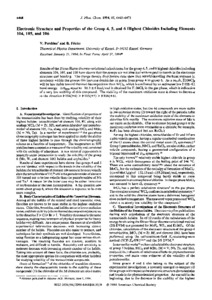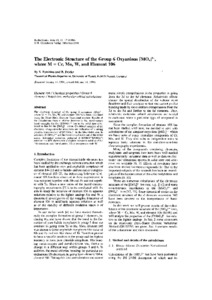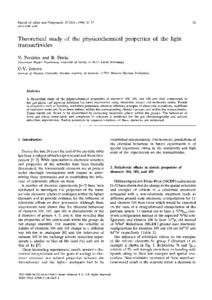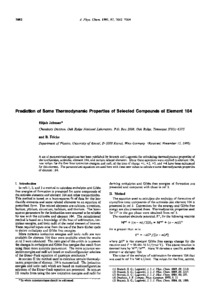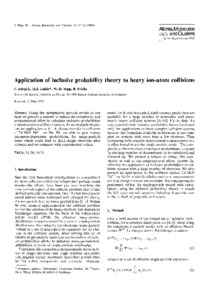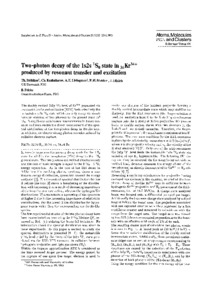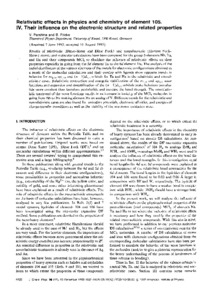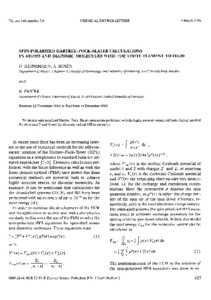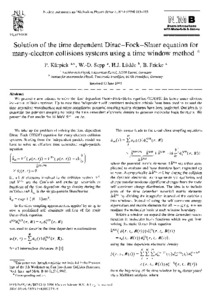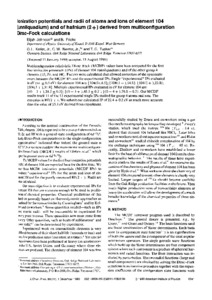Suche
Anzeige der Dokumente 21-30 von 99
Aufsatz
 Electronic structure and properties of the group 4, 5 and 6 highest chlorides including elements 104, 105, and 106
Electronic structure and properties of the group 4, 5 and 6 highest chlorides including elements 104, 105, and 106
(1994)
Results of the Dirac-Slater discrete variational calculations for the group 4, 5, and 6 highest chlorides including elements 104, 105, and 106 have shown that the groups are not identical with respect to trends in the electronic structure and bonding. The charge density distribution data show that notwithstanding the basic increase in covalency within the groups this increase diminishes in going from group 4 to group 6. As a result, E106Cl_6 will be less stable toward thermal decomposition than WCl_6, which is confirmed ...
Aufsatz
 The electronic structure of the group 6 oxyanions [MO_4]^2-, where M = Cr, Mo, W, and element 106
The electronic structure of the group 6 oxyanions [MO_4]^2-, where M = Cr, Mo, W, and element 106
(1994)
The electronic structure of the group 6 oxyanions [MO_4]^2-, where M = Cr, Mo, W, and element 106 have been calculated using the Dirac-Slater Discrete Variational method. Results of the calculations show a relative decrease in the metal-oxygen bond strengths for the [E106O_4]^2- ion in the solid state compared to that for the [WO_4]^2- anion. Calculated energies of the electronic charge-transfer transitions are indicative of a strong possible luminescence of [El06O_4]^2- in the blue-violet area. In solutions [El06O_4]^2- ...
Aufsatz
 Theoretical study of the physicochemical properties of the light transactinides
Theoretical study of the physicochemical properties of the light transactinides
(1994)
A theoretical study of the physicochemical properties of elements 104, 105, and 106 and their compounds in the gas phase and aqueous solutions has been undertaken using relativistic atomic and molecular codes. Trends in properties such as bonding, ionization potentials, electron affinities, energies of electronic transitions, stabilities of oxidation states etc. have been defined within the corresponding chemical groups and within the transactinides.
These trends are shown to be determined by increasing relativistic ...
Aufsatz
 Prediction of some thermodynamic properties of selected compounds of element 104
Prediction of some thermodynamic properties of selected compounds of element 104
(1991)
A set of parametrized equations has been published by Bratsch and Lagowski for calculating thermodynamic properties of the lanthanides, actinides, element 104, and certainrelated elements. Since these equations were applied to element 104, new values for the first four ionization energies and radii of the ions of charge +1, +2, +3, and +4 have been calculated for this element. The parametrized equations are used here with these new values to calculate some thermodynamic properties of element 104.
Aufsatz
 Application of inclusive probability theory to heavy ion-atom collisions
Application of inclusive probability theory to heavy ion-atom collisions
(1992)
Using the independent particle model as our basis we present a scheme to reduce the complexity and computational effort to calculate inclusive probabilities in many-electron collision system. As an example we present an application to K - K charge transfer in collisions of 2.6 MeV Ne{^9+} on Ne. We are able to give impact parameter-dependent probabilities for many-particle states which could lead to KLL-Auger electrons after collision and we compare with experimental values.
Aufsatz
 Two-photon decay of the 1s2s ^1S_0 state in _36Kr^34+ produced by resonant transfer and excitation
Two-photon decay of the 1s2s ^1S_0 state in _36Kr^34+ produced by resonant transfer and excitation
(1991)
The doubly excited 2s2p ^1P_1 level of Kr^{34+} populated via resonant transfer and excitation (RTE) feeds selectively the metastable ls2s ^1 S_0 state which can only decay via simultaneous emission of two photons to the ground state 1s^2 ^1 S_0. X-ray/X-ray coincidence measurements in heavy ionatom collisions enable the direct measurement of the spectral distribution of the two-photon decay in He-like ions. In addition, we observe strong photon cascades indueed by radiative electron capture.
Aufsatz
 Relativistic effects in physics and chemistry of element 105. [Part] IV.
Relativistic effects in physics and chemistry of element 105. [Part] IV.
(1993)
Results of relativistic (Dirac-Slater and Dirac-Fock) and nonrelativistic (Hartree-Fock-Slater) atomic and molecular calculations have been compared for the group 5 elements Nb, Ta, and Ha and their compounds MCl_5, to elucidate the influence of relativistic effects on their
properties especially in going from the 5d element Ta to the 6d element Ha. The analysis of the radial distribution of the valence electrons of the metals for electronic configurations obtained as a result of the molecular calculations and their ...
Aufsatz
 Spin-polarized Hartree-Fock-Slater calculations in atoms and diatomic molecules with the finite element method
Spin-polarized Hartree-Fock-Slater calculations in atoms and diatomic molecules with the finite element method
(1990)
We present spin-polarized Hartree-Fock-Slater calculations performed with the highly accurate numerical finite element method for the atoms N and 0 and the diatomic radical OH as examples.
Aufsatz
 Solution of the time dependent Dirac-Fock-Slater equation for many-electron collisions systems using a time window method
Solution of the time dependent Dirac-Fock-Slater equation for many-electron collisions systems using a time window method
(1994)
We present a new scheme to solve the time dependent Dirac-Fock-Slater equation (TDDFS) for heavy many electron ion-atom collision systems. Up to now time independent self consistent molecular orbitals have been used to expand the time dependent wavefunction and rather complicated potential coupling matrix elements have been neglected. Our idea is to
minimize the potential coupling by using the time dependent electronic density to generate molecular basis functions. We present the first results for 16 MeV S{^16+} on Ar.
Aufsatz
 Ionization potentials and radii of atoms and ions of element 104 (unnilquadium) and of hafnium (2+) derived from multiconfiguration Dirac-Fock calculations
Ionization potentials and radii of atoms and ions of element 104 (unnilquadium) and of hafnium (2+) derived from multiconfiguration Dirac-Fock calculations
(1990)
Multiconfiguration relativistic Dirac-Fock (MCDF) values have been computed for the first four ionization potentials (IPs) of element 104 (unnilquadium) and of the other group 4 elements (Ti, Zr, and Hf). Factors were calculated that allowed correction of the systematic errors between the MCDF IPs and the experimental IPs. Single "experimental" IPs evaluated in eV (to ± 0.1 eV) for element 104 are: [104(0),6.5]; [104( 1 + ),14.8]; [104(2 + ),23.8]; [104(3 + ),31.9]. Multiple experimental IPs evaluated in eV for element ...

